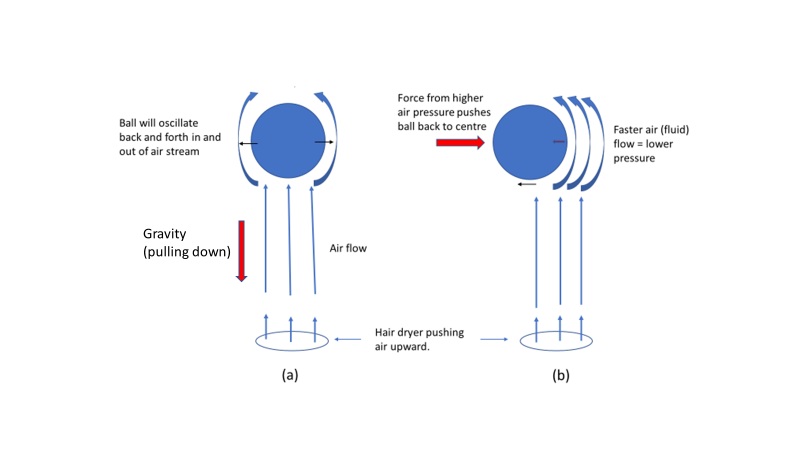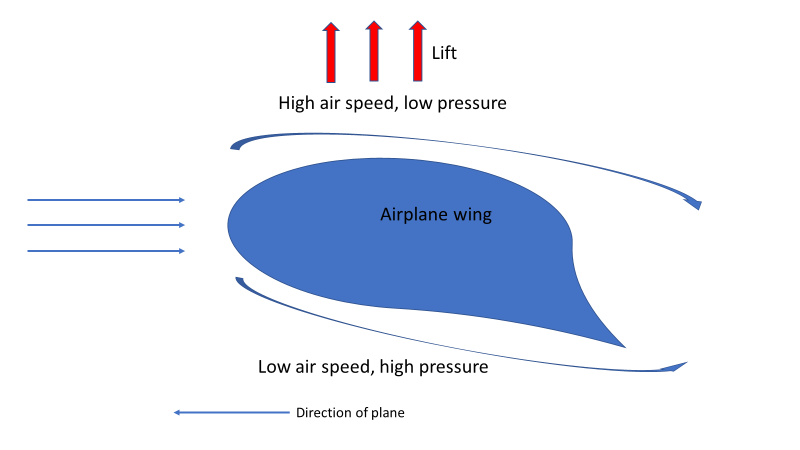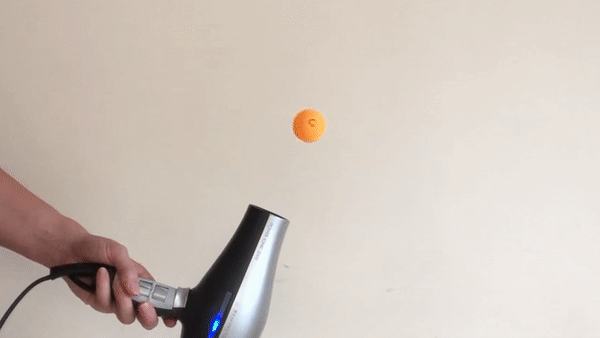What does heat and a dude called Bernouli have to do with deciding when it is too dangerous to fly a plane? Be prepared to do some quiz questions.
The experiments in this activity relate to what enables a plane to get off the ground and what can make it come crashing down again. And about 150 years before the Wright Brothers built the first ever airplane in 1903, there was Daniel Bernouli, a Dutch mathematician who worked out that the faster a fluid flows the lower its pressure. This discovery is known as the Bernouli Principle and it is the reason we can get airplanes to lift off the ground. The fluid we will play with in the following experiments is air because air flows just like a fluid with the same effect.
Download pdf of activity
Learning outcomes
Students will begin to understand the forces involved in flight: Gravity, lift and Bernouli’s Principle (how the rate of fluid flow affects fluid pressure).
Materials
- ping pong ball
- hair dryer
- toilet roll (optional) – or the fancy hair dryer attachment that will achieve the same effect.
Method
- Turn off the heat on the hair dryer so that it blows cool air.
- Turn the hair dryer on and point it straight up.
- Place a ping pong ball into the stream of air (Try place two balls).
- The ball should start floating in mid-air.
- Slowly bend the hair dryer to the side. How far can you bend it before the ball falls?
- Place and hold a toilet roll on top of the hair dryer and repeat the experiment. What do you notice?
- With the hair dryer on an angle and the ball still staying aloft, turn the heat to high. What happens to the ball?
What is happening
You should see the ball suspended in and spinning around in the airstream above the hair dryer. You can draw some pictures on your ball to see this easier. The ball floats at the point where the force from the air flowing up out of the hair dryer and the force from gravity are equal. But if you look really closely at the ball as it sits in the airstream you will notice that it oscillates back and forth. If you have the right camera, try take a close-up, slow motion video of ball in the airstream to see it happening. This is the Bernouli’s principle on display.
Bernouli’s principle
The faster a fluid flows (the fluid in this case being air) the lower its pressure. Air will flow just like a fluid with the same effect. Air will flow from a region of high pressure to one with lower pressure. This is the force keeping the ball in the airstream from the hair dryer. See Figure 1. The ball is oscillating left and right, in and out of the vertical airstream. As it moves left or right out of the air stream, air will flow faster over the side of the ball still in the air stream. This will create an area of lower pressure on that side of the ball. The force on the side of the ball with higher air pressure will push the ball back into the centre of the air stream. Hence the ball will remain suspended in the airstream. See Figure 1(a) and (b).

F
Figure 1 (a) The ball is centred in the air stream where the force of gravity pulling the ball down is equal to the force of the pressure of the air pushing the ball upward. But the ball is oscillating back and forth in the air stream. In (b) the ball has moved out from the centre of the air stream, which mean the air stream from the hair dryer is flowing over one side of the ball faster than the other creating an area of lower pressure on that side of the ball. Air will flow from an area of higher pressure to one of lower pressure, which means the ball will be pushed back into the centre of the air flow.
Tilting the hair dryer
When you tilt the hair dryer, Bernouli’s principle is still working. See Figure 2. When the hair dryer is tilted, the oscillations of the ball will be up and down rather than left or right. When the ball begins to fall down out of the airstream, the lift created by the faster air travelling over the top of the ball that is still in the air stream will push the ball back up into the middle of the airstream again until gravity pulls it back down again, and Bernouli kicks in and pushes it up again…..and so on.
The toilet roll
Air pressure keeps the ball in the stream of air when you tilt the hair dryer because fast air rushes past the ball, keeping it in place. When you use a toilet roll, the air is being pushed through a smaller space. This causes the air to move faster, the ball to float higher, or you can tilt the hair dryer a bit more. This is why planes with a heavier load must travel faster along the runway to generate sufficient lift to get off the ground. That is, they need to generate a faster flow of air over the wings to generate greater lift.
Adding heat When the hair dryer was tilted, what happened to the ball when you turned the heat on the hair dryer up high? The ball should fall to the ground. This is because warmer air has a lower density. The warmer the air the more the air particles get excited and bounce around more and spread out. Or in other words they are not packed together as tightly as in colder air, meaning there is effectively less air molecules in hot air than cold air. That means there are less air molecules to push back on the wing and provide lift. Hot air (with lower density) has lower (barometric) pressure than cooler air. Hence, when we blow hot air across the ball, there is already low air pressure underneath the ball because the air is hot. The difference between the low air pressure underneath the ball and the now only slightly lower air pressure above the ball is not great enough to provide the lift required to keep the ball from falling.
This also why planes can’t go really high altitudes or into space. At such altitudes there is not much air (really low air pressure). In space there is no air – and no air pressure – and therefore no lift.
Go big. Play around with different size balls and bigger air blowing machines. Got a leaf blower handy?
For the visual explanation of all this check out FLEET’s Prof. Kris Helmerson in the video below.
Experiment two
All you need is a thin strip of tissue paper about 15cm long (or equally light paper that will naturally fold or droop down when you hold one end)
Method
Hold one end of the strip of paper against chin (just below lower lip) and blow across the paper.
What do you think will happen to the paper?
a. The paper will press down against your chin?
b. The paper will rise up to be horizontal?
c. The paper will stay where it is?
What is happening?
Again, Bernouli’s principle applies. As you blow air across the top of the paper you are creating an area of lower pressure on the top of the paper. This creates an upward force on the paper pushing it up to the horizontal position. This lift is the force that get airplanes off the ground. The answer therefore is b) The paper will rise up to be horizontal.
Wing design and Bernouli
As an airplane speeds along the runway, the shape of the aircraft wing forces the air to move over the top of the wing faster than it moves below the wing. As with the tissue paper on the chin, the air pressure above the wing is lower than below the wing creating an upward force (Lift). The plane needs to travel fast enough to create a big enough pressure difference between the top and bottom of the wing to generate sufficient lift to get the plane off the ground. See Figure 3.

Figure 2. When the hair dryer is tilted the higher air pressure underneath the ball creates lift pushing the ball back into the centre of the air stream.

Figure 3. The shape of an airfoil (wing) forces air to travel over the top of the wing faster than it will travel below the wing. This creates a pressure difference between the top and bottom of the wing with the bottom of the wing being a region with higher pressure compared to the top of the wing. The faster the plane goes the greater the difference in air speed above and below the wing and therefore the greater the difference in air pressure. The greater the difference in air pressure, the greater the lift.
Test your understanding
In June 2017, more than 40 flights were cancelled in Phoenix Arizona when the temperature was forecast to hit 48 degrees. Why were the flights cancelled? Based on what you have learned above, which of the following answers do you think is correct?
- The air was too hot for the planes to take off
- The planes’ air-conditioning would overheat
- The ashphalt runways had start to melt
Check your answer here
Remember that warmer air has a lower density and therefore lower pressure than cooler air. Remember also what happened to the ball above the hair dryer when you turned the heat on. If the ball was a plane, it would not end well for the plane.
A question to ponder: Will climate change and the increase in extreme heat days we are expected to experience in Australia affect the number of days planes are not allowed to fly?
Check the bbc news story the reported the incident.
And for a deeper look into the science and the implications of climate change check this Discover Magazine story.
Head back to FLEET schools or All Home Science activities.

